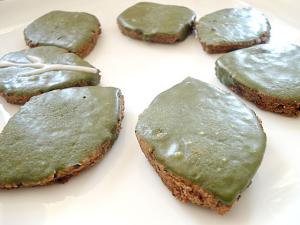
[From the archives. These sesame cookies with matcha icing look and taste quite dramatic. In leaf shapes they are rather spring-like, but try simple rounds or squares for year-round appeal. Originally published in April 2007.]
Flavor wise black sesame seeds aren't that different, if at all, from white or brown sesame seeds. But there is something about their dramatic black-to-grey color that is quite exciting. At the moment I'm quite enamored with black sesame seeds, and have been using them instead of the regular brown ones in everything from sauces to salads.
These leaf shaped cookies contain toasted and ground black sesame seeds, dark brown muscovado sugar, and whole wheat flour, and are decorated with matcha (powdered tea) royal icing. The sweetness is quite restrained, both in the cookie and in the icing. You are first hit by the tea-flavored, very slightly bitter icing, followed by the nutty darkness of the cookie. It's an intriguing combination. They are a wonderful accompaniment to tea, black or green, hot or iced. If the ultimate cookie to you means something very sweet and gooey you may not like these. They are quite adult cookies.
I had to shoot the pictures in a hurry, because they were disappearing faster than almost any other cookie I've made recently.
Since I don't have a leaf shaped cookie cutter, I just made a simple paper template and cut the leaves out with a knife. You can cut them out into any shape you'd like of course, though given the coloring leaves seem appropriate. Quite spring-like, in fact.
Filed under:
dessert japanese baking cookies favorites tea